Don’t put all your eggs in one basket: Bangladesh tries maize cropping for feed
CIMMYT E-News, vol 6 no. 2, February 2009
 Demand for maize has popped up across Asia, but much of the grain is enjoyed by poultry, not people. In Bangladesh, maize is a fairly new crop, yet demand in this country already mirrors that of neighboring nations like China and India. A recent CIMMYT report explores these emerging trends and the efforts to incorporate sustainable and economically viable maize cropping systems into a traditionally rice-based country.
Demand for maize has popped up across Asia, but much of the grain is enjoyed by poultry, not people. In Bangladesh, maize is a fairly new crop, yet demand in this country already mirrors that of neighboring nations like China and India. A recent CIMMYT report explores these emerging trends and the efforts to incorporate sustainable and economically viable maize cropping systems into a traditionally rice-based country.
“Simply put, people have more money,” says Olaf Erenstein, a CIMMYT agricultural economist. “Asia’s population growth has slowed and incomes have increased. This means dietary demands and expectations are changing as well.”
With extra money in their pockets, many people across Asia are starting to desire something with a bit more bite. In the past 40 years, increased prosperity and a related meat demand have sent two-thirds of global maize production toward animal feed instead of direct consumption. Currently, 62% of maize in Asia is used to feed livestock while only 22% goes straight to the dinner plate. This is not surprising, as total meat consumption in the seven major Asian maize-producing countries1 rose 280% between 1980 and 2000. Poultry, particularly, plays a large role. During the same time period, poultry production rose 7% each year in Asia, compared to a 5% global average.
The bare-bones reason for this shift is that it takes more grain to produce meat than would be used if people ate the product directly. Grain-to-meat conversion ratios for pork are on the order of 4:1. Chicken is more efficient, requiring only 2 kilograms of grain feed for a kilogram of growth. Either way, when people substitute meat for grain, grain production must increase to meet the demand.
From a farmer’s perspective, this is not a bad thing, and what is occurring now in Bangladesh illustrates how farmers can benefit, according to a recently published CIMMYT study. With a 15%-per-year increase in Bangladesh’s poultry sector since 1991, the feed demand has opened a new market for maize. And since the country’s current average per person poultry consumption is at less than 2 kg a year—compared to almost 4 kg in Pakistan, 14 kg in Thailand, and 33 kg in Malaysia—the maize and poultry industries have plenty of room to spread their wings.
What came first: The chicken or the seed?
The poultry industry in Bangladesh employs five million people, with millions of additional households relying on poultry production for income generation and nutrition. “Only in the past 10 to 15 years, as many people got a bit richer, especially in urban centers, did the market for poultry products, and therefore the profitability of maize, take off in Bangladesh,” says Stephen Waddington, who worked as regional agronomist in the center’s Bangladesh office during 2005-07 and is a co-author of the CIMMYT study.
“Many maize growers keep chickens, feed grain to them, and sell the poultry and eggs; more value is added than by just selling maize grain,” he says. “Most Bangladeshis have no history of using maize as human food, although roasting cobs, popcorn, and mixing maize flour with wheat in chapattis are all increasing.” Waddington adds that maize could grow in dinnertime popularity, as the price of wheat flour has increased and the price of maize grain remains almost 40% lower than that for wheat.
Worldwide, more maize is produced than any other cereal. In Asia, it is third, after rice and wheat. But due to the increasing demand for feed, maize production in Asia has almost quadrupled since 1960, primarily through improved yields, rather than area expansion. Future rapid population growth and maize demand will lead to maize being grown in place of other crops, the intensification of existing maize lands, the commercialization of maize-based production systems, and the expansion of maize cultivation into lands not currently farmed. The International Food Policy Research Institute estimates that Asia will account for 60% of global maize demand by 2020.
Maize in Bangladesh is mainly a high-input crop, grown with hybrid seed, large amounts of fertilizer, and irrigation. While a successful maize crop requires high inputs, it also provides several advantages. “Maize is more than two times as economical in terms of yield per unit of land as wheat or Boro rice,” says Yusuf Ali.”Maize also requires less water than Boro rice and has fewer pest and disease problems than Boro rice or wheat.” The maize area in Bangladesh is increasing around 20% per year.
Maize-rice cropping challenges
“The high potential productivity of maize in Bangladesh has yet to be fully realized,” says Yusuf Ali, a principal scientific officer with the On-Farm Research Division (OFRD) of the Bangladesh Agricultural Research Institute (BARI) and first author of the CIMMYT study. Bangladesh has a subtropical climate and fertile alluvial soils, both ideal for maize. From only a few thousand hectares in the 1980s, by 2007-08 its maize area had expanded to at least 221,000 hectares, he said.
Maize in Bangladesh is cropped during the dry winter season, which lasts from November to April. The other two crops commonly grown during winter are high-yielding irrigated rice (known in Asia as “Boro,” differentiating it from the flooded paddy rice common throughout the region) and wheat. Adding another crop into the mix and thereby increasing cropping diversity is beneficial for farmers, offering them more options.
Rice, the traditional staple cereal crop in Bangladesh, is grown throughout the country year round, often with two to three crops per year on the same land. So as the new crop on the block, maize must be merged with existing cropping patterns, the most common of which is winter maize sown after the harvest of paddy rice. And since rice is the key to food security in Bangladesh, farmers prefer to grow longer-season T. aman rice that provides higher yields than earlier-maturing varieties. This delays the sowing of maize until the second or third week of December. Low temperatures at that time slow maize germination and growth, and can decrease yields more than 20%. In addition, the later-resulting harvest can be hindered by early monsoon rains, which increase ear rot and the threat of waterlogging.
Another problem with maize-rice cropping systems is that the two crops require distinct soil environments. Maize needs loamy soils of good tilth and aeration, whereas rice needs puddled wet clay soils with high water-holding capacity. Puddling for rice obliterates the soil structure, and heavy tillage is required to rebuild the soil for maize. This is often difficult due to a lack of proper equipment, time, or irrigation. Moreover, excessive tillage for maize can deplete soils of nutrients and organic matter. Thus, as maize moves into rice-based cropping systems, agronomists need to develop sustainable cropping patterns, tillage management options, and integrated plant nutrient systems.
Support and supplies vital for success
“For a new crop like hybrid maize to flourish, there needs to be a flow of information and technology to and among farmers,” Waddington says.
In collaboration with the Bangladesh Agricultural Research Institute (BARI), the Department of Agricultural Extension (DAE), and various non-governmental organizations, CIMMYT provided hands-on training for maize production and distributed hybrid seed (which tends to be higher-yielding and more uniform, but must be purchased and planted each year to experience full benefits) to over 11,000 farm families across 35 districts in Bangladesh from 2000-06. A CIMMYT report showed that farmers who received the training were more likely to plant their maize at the best times and also irrigated more frequently and adopted optimal cropping patterns and fertilizer use, resulting in higher yields and better livelihoods.
“This training is vital, since the country is full of tiny, intensively-managed farms. Maize tends to be grown by the somewhat better resourced farmers, but these are still small-scale, even by regional standards,” says Waddingon, adding that farm families were eager to improve their maize-cropping knowledge and their fields.
Other efforts include BARI’s development and release of seven maize hybrids largely based on germplasm from CIMMYT. Two of the hybrids consistently produce comparable grain yields to those of commercial hybrids. The Institute is also working on short duration T. aman rice varieties that have yields and quality comparable to traditional varieties and could thus allow timelier planting of maize.
Power tillers seed the future
Another important advancement is the power-tiller-operated seeder (PTOS) created by the Wheat Research Center (WRC) of BARI. Originally for wheat, the machine has been modified and used to plant maize. Additional PTOSs need to be built, tested, and marketed. Another promising piece of equipment in the works is a power-tiller-operated bed former. Because making and destroying soil beds between every rice/maize rotation is not practical or efficient, the WRC-BARI/CIMMYT farm machinery program is working on a tiller that simultaneously creates a raised bed, sows seed, and fertilizes. This is vital since the turnaround time between rice and maize crops is limited. Like the PTOS, further testing and promotion are needed.
Though much work is still required to incorporate maize fully and sustainably into Bangladesh’s cropping systems, it has already spread across the country quicker than anticipated. Even so, scientists believe future production will fall short of demand. This gap provides farmers an additional crop option, and plants maize in a good position for future growth in Bangladesh.
For more information: Enamul Haque, program manager, CIMMYT-Bangladesh office (e.haque@cgiar.org).
1 China, India, Indonesia, Nepal, the Philippines, Thailand, and Vietnam were identified in a CIMMYT study as Asian countries with more than 100 K hectares sown with maize. At the time of the study, Bangladesh did not meet this maize area requirement and therefore is not included in this statistic.
 The larger grain borer is taking a beating from CIMMYT breeders in Kenya as new African maize withstands the onslaught of one of the most damaging pests.
The larger grain borer is taking a beating from CIMMYT breeders in Kenya as new African maize withstands the onslaught of one of the most damaging pests.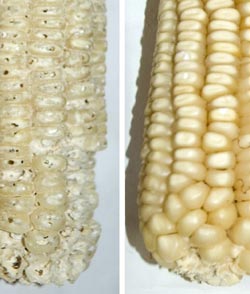 Even in Latin America, where it has co-evolved with natural predators, losses are significant. In Africa, where there are no similar predators to control the insect, its spread has been most dramatic. Attempts to introduce some of those predators to Africa to control the borer (a technique called biological control) have met with limited success and regionally concerted action is essential if biological control is to be effective across borer-infested areas. Researchers also studied the habits of the borer, hoping to find ways to reduce the damage it does. They discovered that it needs a solid platform, such as that provided by maize kernels still on the cob, before it will bore into a kernel. Unfortunately African farmers often store maize on the cob, increasing the potential for borer damage. By shelling the maize and storing the kernels off the cob, the damage can be reduced by small amounts, but losses are still very high. This is what makes the development of new varieties, where the resistance lies in the seed, so exciting.
Even in Latin America, where it has co-evolved with natural predators, losses are significant. In Africa, where there are no similar predators to control the insect, its spread has been most dramatic. Attempts to introduce some of those predators to Africa to control the borer (a technique called biological control) have met with limited success and regionally concerted action is essential if biological control is to be effective across borer-infested areas. Researchers also studied the habits of the borer, hoping to find ways to reduce the damage it does. They discovered that it needs a solid platform, such as that provided by maize kernels still on the cob, before it will bore into a kernel. Unfortunately African farmers often store maize on the cob, increasing the potential for borer damage. By shelling the maize and storing the kernels off the cob, the damage can be reduced by small amounts, but losses are still very high. This is what makes the development of new varieties, where the resistance lies in the seed, so exciting. CIMMYT researchers found resistance to the borer in the Center’s germplasm bank, in maize seed originally from the Caribbean. The bank holds 25,000 unique collections of native maize races. By using conventional plant breeding techniques, crossing those plants with maize already adapted to the conditions found in eastern Africa, Mugo and the breeding team were able to combine the resistance of the Caribbean maize with the key traits valued by Kenyan maize farmers. The maize was tested for resistance at the KARI research station in Kiboko, Kenya. Larger grain borers were placed in glass jars with a known weight of maize. Weight changes to the maize and a visual assessment of damage were recorded, allowing researchers to select the best lines. The result is new maize varieties that will benefit farmers in Kenya and help reduce Kenya’s dependence on imported maize for national food security.
CIMMYT researchers found resistance to the borer in the Center’s germplasm bank, in maize seed originally from the Caribbean. The bank holds 25,000 unique collections of native maize races. By using conventional plant breeding techniques, crossing those plants with maize already adapted to the conditions found in eastern Africa, Mugo and the breeding team were able to combine the resistance of the Caribbean maize with the key traits valued by Kenyan maize farmers. The maize was tested for resistance at the KARI research station in Kiboko, Kenya. Larger grain borers were placed in glass jars with a known weight of maize. Weight changes to the maize and a visual assessment of damage were recorded, allowing researchers to select the best lines. The result is new maize varieties that will benefit farmers in Kenya and help reduce Kenya’s dependence on imported maize for national food security.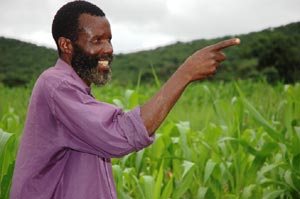 Farmer Hendrixious Zvamarima, of Shamva village, in Mashonaland Central Province, Zimbabwe, saw a neighbor who, instead of cultivating the soil, sowed his maize seed directly into unplowed soil and residues from last year’s crop. “I was wasting my time using the plow,” says Zvamarima, “so I decided to try the new methods.”
Farmer Hendrixious Zvamarima, of Shamva village, in Mashonaland Central Province, Zimbabwe, saw a neighbor who, instead of cultivating the soil, sowed his maize seed directly into unplowed soil and residues from last year’s crop. “I was wasting my time using the plow,” says Zvamarima, “so I decided to try the new methods.”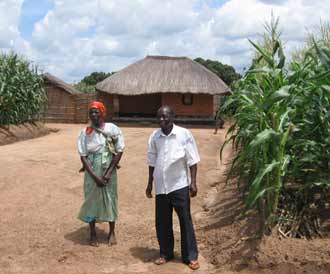
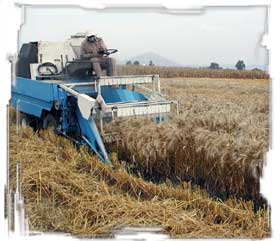 CIMMYT puts stem rust resistant seeds into partners’ hands for testing.
CIMMYT puts stem rust resistant seeds into partners’ hands for testing.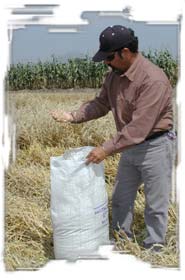 CIMMYT is not only distributing existing stem-rust-resistant wheats, but is part of efforts to breed materials that will lead to the release of new varieties. A range of sources, particularly lines that have shown Ug99 resistance in Kenya over two years’ testing, are being used to enhance the diversity of stem rust resistance in elite germplasm and valued cultivars. Singh and his team aim to create wheats with durable resistance to Ug99, by ‘pyramiding’ several minor resistance genes.
CIMMYT is not only distributing existing stem-rust-resistant wheats, but is part of efforts to breed materials that will lead to the release of new varieties. A range of sources, particularly lines that have shown Ug99 resistance in Kenya over two years’ testing, are being used to enhance the diversity of stem rust resistance in elite germplasm and valued cultivars. Singh and his team aim to create wheats with durable resistance to Ug99, by ‘pyramiding’ several minor resistance genes.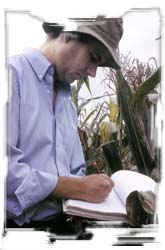 Now that all of CIMMYT’s new program directors have been officially installed, it is time to get acquainted with them, as well as their ideas and plans for the programs. This month we feature Rodomiro Ortiz, director of the Intensive Agro-Ecosystems Program.
Now that all of CIMMYT’s new program directors have been officially installed, it is time to get acquainted with them, as well as their ideas and plans for the programs. This month we feature Rodomiro Ortiz, director of the Intensive Agro-Ecosystems Program.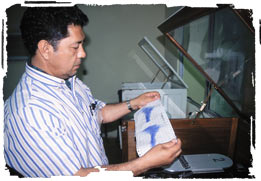 CIMMYT’s wheat quality lab expands and upgrades to meet growing demand of wheat for diverse food uses.
CIMMYT’s wheat quality lab expands and upgrades to meet growing demand of wheat for diverse food uses.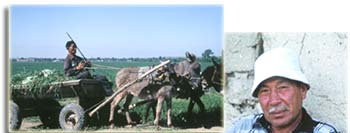
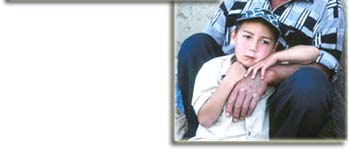
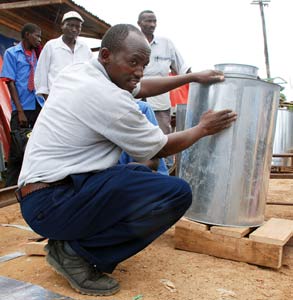 Six mouths are a lot to feed so Pamela Akoth, a 39-year-old Kenyan farmer and mother to half a dozen children, doesn’t want any weevils or borers—two of the most common post-harvest pests—nibbling at her grain supply. Akoth grows maize on 0.7 hectares in Homa Bay, western Kenya. In the past, she stored her grain in a traditional granary: a structure built with mud, branches, and cow dung that allows free entry to the maize weevil and the larger grain borer, the two most damaging pests of stored maize in Africa. Infestation starts in the field and continues after harvest when grain is stored. Losses of 10-20% are reported three months after storage, and this goes up to more than 50% after six months.
Six mouths are a lot to feed so Pamela Akoth, a 39-year-old Kenyan farmer and mother to half a dozen children, doesn’t want any weevils or borers—two of the most common post-harvest pests—nibbling at her grain supply. Akoth grows maize on 0.7 hectares in Homa Bay, western Kenya. In the past, she stored her grain in a traditional granary: a structure built with mud, branches, and cow dung that allows free entry to the maize weevil and the larger grain borer, the two most damaging pests of stored maize in Africa. Infestation starts in the field and continues after harvest when grain is stored. Losses of 10-20% are reported three months after storage, and this goes up to more than 50% after six months.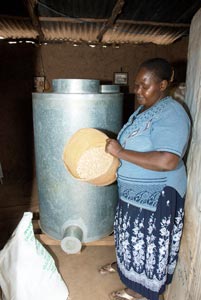 Local manufactureres cash in on silo demand
Local manufactureres cash in on silo demand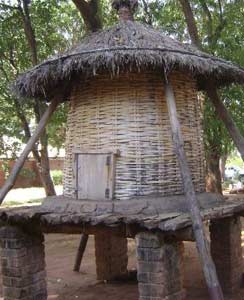 “I have used the silos for several years now, and I am convinced that this is the best method to store grain,” Sister Barbara says. “With other storage methods, we would lose up to 90% of our stored grain—now we lose nothing.” Schools have been early adopters of metal silos because many grow and store grain year-long to feed their students.
“I have used the silos for several years now, and I am convinced that this is the best method to store grain,” Sister Barbara says. “With other storage methods, we would lose up to 90% of our stored grain—now we lose nothing.” Schools have been early adopters of metal silos because many grow and store grain year-long to feed their students.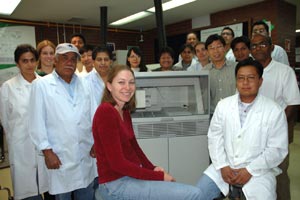 A quiet revolution is taking place in CIMMYT’s biotechnology labs. The team has just received a new generation of genotyping machines. These semi-automated work-horses will make it much easier to determine whether breeding lines contain specific useful genes. It is hoped that this will help maize and wheat breeders—through a process known as marker-assisted selection (MAS)—to make breeding more effective and get crop varieties with valuable traits to poor farmers more quickly.
A quiet revolution is taking place in CIMMYT’s biotechnology labs. The team has just received a new generation of genotyping machines. These semi-automated work-horses will make it much easier to determine whether breeding lines contain specific useful genes. It is hoped that this will help maize and wheat breeders—through a process known as marker-assisted selection (MAS)—to make breeding more effective and get crop varieties with valuable traits to poor farmers more quickly.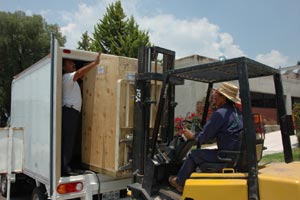 The two ABI 3700 machines have been generously donated to CIMMYT by DuPont through its Pioneer Hi-Bred seed business, reflecting a fruitful collaborative relationship of more than a decade’s standing. Until now, CIMMYT has run most of its marker-assisted selection work on manual, gel-based electrophoresis apparatuses. In addition, analyses of genetic relationships between different wheat or maize lines have been run on older ABI genotyping machines, including two based on the previous, much slower generation of gel-based machines. The new machines can handle many more samples—96 each at a time—but it’s the savings in hands-on time that makes the real difference. “There’s no comparison,” says Marilyn Warburton, Head of CIMMYT’s Applied Biotechnology Center. “It will take us ten minutes to load one of these new machines, whereas it takes about four hours to make and load a manual electrophoresis gel.”
The two ABI 3700 machines have been generously donated to CIMMYT by DuPont through its Pioneer Hi-Bred seed business, reflecting a fruitful collaborative relationship of more than a decade’s standing. Until now, CIMMYT has run most of its marker-assisted selection work on manual, gel-based electrophoresis apparatuses. In addition, analyses of genetic relationships between different wheat or maize lines have been run on older ABI genotyping machines, including two based on the previous, much slower generation of gel-based machines. The new machines can handle many more samples—96 each at a time—but it’s the savings in hands-on time that makes the real difference. “There’s no comparison,” says Marilyn Warburton, Head of CIMMYT’s Applied Biotechnology Center. “It will take us ten minutes to load one of these new machines, whereas it takes about four hours to make and load a manual electrophoresis gel.”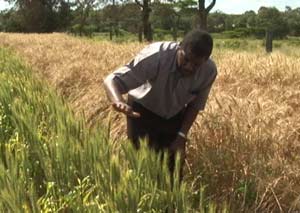 At an agricultural research station in Kenya, ingenuity, improvised tools, and a small group of talented, dedicated researchers and technicians using good science, are on the front line of the battle to prevent a potential multi-billion dollar crop disaster for the world.
At an agricultural research station in Kenya, ingenuity, improvised tools, and a small group of talented, dedicated researchers and technicians using good science, are on the front line of the battle to prevent a potential multi-billion dollar crop disaster for the world.
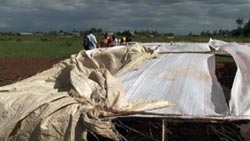

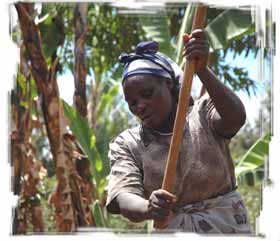 Improved maize makes a big difference in the lives of smallholder farmers on the slopes of Mt Kenya.
Improved maize makes a big difference in the lives of smallholder farmers on the slopes of Mt Kenya.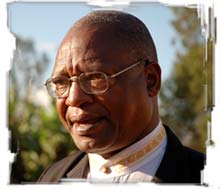

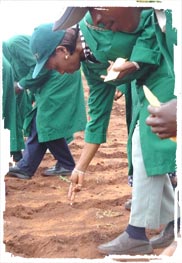 Kenya broke historic agricultural ground in a protected field on May 27 when it sowed its first transgenic maize seeds into local soil. Supported by the Syngenta Foundation for Sustainable Agriculture and the Rockefeller Foundation, this experiment is the first of its kind in the region. The Bt maize plants that sprout will be resistant to stem borer, an insect that drills into the maize stalk and causes significant losses to Kenyan harvests.
Kenya broke historic agricultural ground in a protected field on May 27 when it sowed its first transgenic maize seeds into local soil. Supported by the Syngenta Foundation for Sustainable Agriculture and the Rockefeller Foundation, this experiment is the first of its kind in the region. The Bt maize plants that sprout will be resistant to stem borer, an insect that drills into the maize stalk and causes significant losses to Kenyan harvests.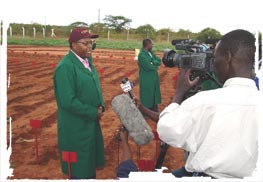
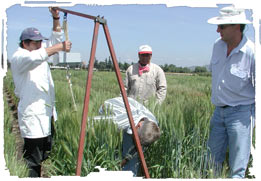 Techniques from maize may make better wheats.
Techniques from maize may make better wheats.